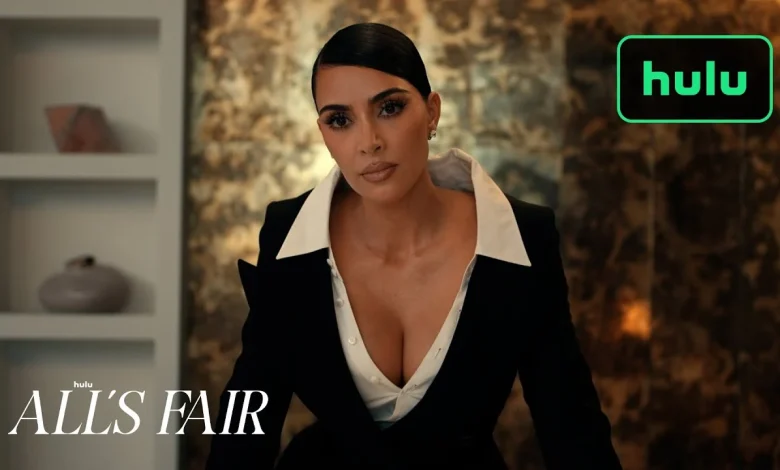All’s Fair Season 1: A High-Glam Leap Into Legal Drama

Ryan Murphy’s All’s Fair arrived with the force of a cultural hurricane. Armed with an A-list ensemble, a glossy Los Angeles backdrop, and a heavy dose of Murphy-style camp, the first season promised a fierce, female-driven legal drama. Instead, it ignited one of the most polarized TV conversations of the decade: critics panned it, viewers binged it, and social media turned it into a spectacle all its own.
Watch this on Hulu in Canada, Hulu in UK, Hulu in Australia, Hulu in Spain and Hulu in Germany.
A Legal Drama Dipped in Couture
The premise is deliciously simple: an all-female divorce law firm in Los Angeles navigates high-stakes breakups, celebrity scandals, and internal power plays. But this is no ordinary workplace drama. It’s dripping in luxury, ambition, and attitude — and it knows it.
The story centers on Allura Grant, played by Kim Kardashian in a role that made headlines before a single scene aired. She is the perfectly styled, emotionally impenetrable leader of a firm that operates more like a fashion house than a legal practice. Her associates and partners — portrayed by heavyweights like Sarah Paulson, Glenn Close, Niecy Nash-Betts, Naomi Watts, and Teyana Taylor — each bring radically different energies, from icy authority to fiery chaos.
Cases range from explosive celebrity divorces to toxic million-dollar marital wars. But make no mistake: the law is mostly a backdrop. All’s Fair is a character drama wearing the clothes of a legal one. The real battles are personal, psychological, and — in true Murphy fashion — flamboyantly melodramatic.
Critics vs. Viewers: A Wild Divide
Season 1 became one of the most fascinating case studies in audience-critic disagreement.
Critics, almost unanimously, trashed it. Reviews labeled it shallow, overworked, underwritten, tonally confused, and even “a crime against television.” Much of the criticism zeroed in on two things: the writing, and Kim Kardashian’s performance. Reviewers argued that Kardashian seemed uncomfortable in the lead role, and that the show tried to mask weak storytelling with couture wardrobes and expensive set pieces.
But then something unexpected happened: viewers kept watching — and many enjoyed it.
The audience response was wildly mixed, but undeniably passionate. Some viewers hate-watched it, others declared it campy gold, and plenty fell somewhere in the middle: bewildered, entertained, occasionally frustrated, and always curious about what absurd twist might come next.
On social platforms, fans described it as:
- “So bad it’s good.”
- “High-octane camp with a budget.”
- “A train wreck I couldn’t look away from.”
- “A fashion show with custody hearings.”
And yet… that unusual blend clearly worked on some level, because conversation about the show only grew louder as the season progressed.
Why Viewers Can’t Look Away
Even if All’s Fair isn’t the most polished drama of the year, there are undeniable reasons why people binged Season 1.
1. The Aesthetic Is Addictive
The show’s visual identity is intoxicating: glass-and-chrome offices, couture power suits, towering heels strutting through marble hallways, and a color palette that screams wealth and weaponized femininity. It’s aspirational, escapist, and almost comically heightened.
2. The Camp Energy Feels Intentional
Whether or not the show set out to be satirical, it landed squarely in camp territory. The heightened emotions, dramatic monologues, eyebrow-arching confrontations, and gorgeously over-styled court entrances all feel like Murphy leaning into the absurdity.
3. The Cast Keeps It Watchable
Even when the writing wobbles, performers like Sarah Paulson, Glenn Close, and Niecy Nash-Betts anchor the story with skill and charisma. They know exactly what kind of show they’re in, and they lean into it with gusto.
4. The Plot Twists Are Pure Popcorn
Divorces that turn violent. Affairs. Betrayals inside the firm. Sudden character revelations. Dramatic walk-outs and even more dramatic walk-ins. All’s Fair piles on the twists like a soap opera wearing designer heels — and that’s part of the fun.
The Core Themes: Feminism, Power, and Image
The show wants to say something about modern womanhood, power imbalance, and how patriarchy shapes legal and emotional battles. It doesn’t always land those messages cleanly. At times, the feminist themes feel meaningful; at others, they’re overshadowed by glitz and spectacle.
Still, Season 1 raises interesting questions:
- What does empowerment look like in a world obsessed with image?
- Can a feminist workplace thrive when built on ego and ambition?
- How do women navigate a legal world historically dominated by men — and does glamor help or hinder their authority?
The show’s answer is never clear-cut, but it consistently forces viewers to think about the tension between sincerity and performance — in law, in gender politics, and in personal identity.
Kim Kardashian: The Most Polarizing Element
Kim Kardashian’s casting was controversial from day one. In the series, she delivers a controlled, icy performance — and that, arguably, is the point. Allura Grant isn’t meant to be warm or emotionally accessible. She’s meant to be unreadable, intimidating, and visually flawless.
Some viewers argue Kardashian is simply playing to her strengths: commanding presence, composed delivery, and an aura of unreachable glamour. Critics argue the opposite, insisting she lacks range and emotional depth.
But either way, she is the reason people tuned in. And in TV, that counts for something.
The Moments That Shocked Viewers
Season 1 contains moments that sparked intense discussion:
- An unexpected sexual assault subplot that shifted the tone dramatically.
- A courtroom scene where fashion, not law, steals the spotlight.
- Fierce confrontations between partners that escalate into near-warfare.
- An ending that hints the firm’s internal fractures have only begun.
These tonal swings — from glossy camp to dark drama — are part of what made the show feel chaotic, unpredictable, and unforgettable.
Is All’s Fair Actually Good?
The honest answer: it depends on what you want from your TV.
If you want:
- razor-sharp legal realism
- tightly constructed dramatic arcs
- grounded performances
- or a consistent tone
…this probably isn’t the show for you.
But if you love:
- high-gloss escapism
- camp energy
- messy drama
- big personalities
- and fashion as character development
…you might find All’s Fair irresistible.
Final Verdict: A Beautiful Disaster — And a Wildly Entertaining One
Season 1 of All’s Fair is a glittering contradiction. It’s messy but captivating, stylish but uneven, shallow yet sometimes surprisingly bold. It’s not prestige TV — and it doesn’t have to be. It’s a high-fashion, high-drama ride that thrives on excess and spectacle.
You may laugh at it, cringe at it, criticize it, or binge it in one sitting. But you will react to it — and that’s exactly why it became one of the most talked-about shows of the year.





